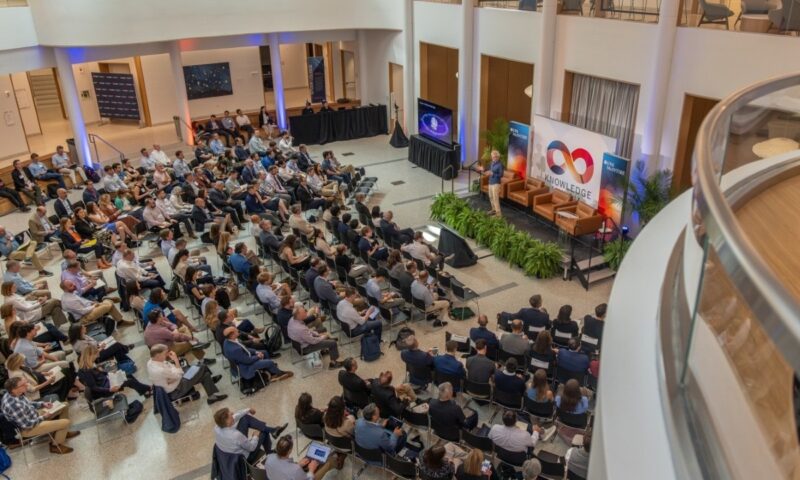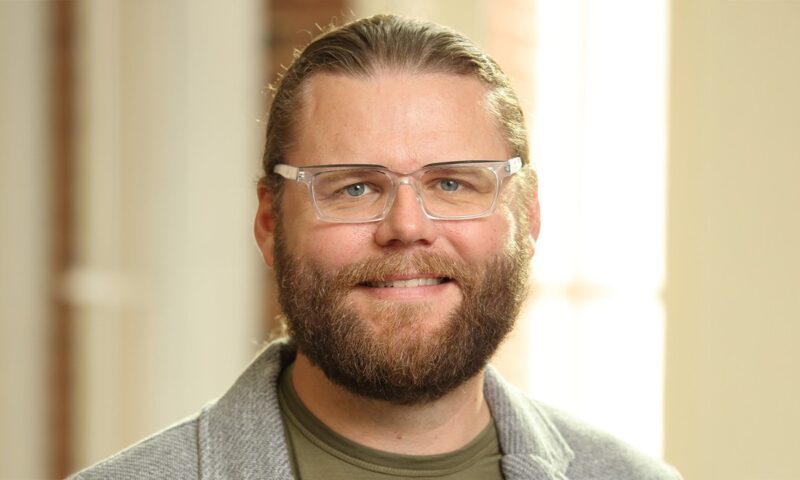
Top row: Corinne Baker, Alexandra Dimas (A&S ’20). Bottom row: Helena Iserhard, Charlie Trinco
Representation is important. For example, recent U.S. Bureau of Labor Statistics data finds that despite accounting for nearly 47% of the country’s workforce, women hold less than 30% of corporate C-suite positions and only slightly more than 26% of information technology-related jobs.
For those who hold the top leadership roles, even the previous cited percentages may be tenuous. In February 2023, YouTube CEO Susan Wojcicki stepped down from her high-profile position; she is only one of several women tech execs to have resigned in the past few months, choosing to back out of the spotlight. While many speculate that the trend of female leadership departures may be the result of burnout connected to the pandemic, McKinsey’s Women in the Workplace report from October 2022 says the numbers for women exiting these roles are at the highest rate ever.
And so, across industries, where both business strategy and tech know-how are critical for success—as well as graduate school management programs that prepare people to take on those roles—female representation continues to be a significant issue. As such, there has been an increased focus to recruit, train, and promote strong women candidates for positions in these historically underrepresented fields.
It’s for this very reason that the UVA McIntire School of Commerce’s innovative M.S. in the Management of IT (M.S. in MIT) Program is excited to report a demographic shift challenging the longstanding status quo: Its current class has enrolled a record-setting number of women—53%—intent on leading organizations at the intersection of business and technology.
The program is attracting women representing a range of backgrounds and goals. We spoke to four Class of 2023 M.S. in MIT students who came to UVA’s Northern Virginia campus on the strength of a diversity of undergraduate programs and careers. Corinne Baker, Alexandra Dimas (A&S ’20), Helena Iserhard, and Charlie Trinco explain how the M.S. in MIT is preparing them to be informed leaders with increased opportunities for career success.
Why They Chose the M.S. in MIT
Baker majored in Supply Chain Management and Information Systems at the University of Maryland and is Technology Third Party Manager at Capital One; Dimas earned her B.A. in Computer Science from UVA and serves as a Network Security Consulting Engineer at Cisco Systems. As an undergrad at George Washington University, Iserhard studied International Affairs and is now a Change Manager at the World Bank Group; Trinco majored in Finance at Elon University and is an HR Technology Product Manager at Coinbase.
One belief all four had in common when they enrolled is how they envisioned McIntire’s M.S. in MIT could help them to achieve their various career aims.
“I saw the program as an opportunity to better understand the needs of my business customers and to open up new career opportunities for myself in tech roles,” says Baker, considering her position as a liaison between business and technology, requiring her to understand both. “The program also aligned with the experience I hoped to get out of grad school, one where I could continue working and the curriculum would fall hand-in-hand with what I do on a daily basis,” she says.
Dimas, an engineer, says that while she’s been trained to take care of technical configurations in her daily work, the position doesn’t offer many opportunities for exposure to business activity within her company. “I knew that in order to continue to grow at Cisco and in my career, I needed to ensure I could speak to the technical and the business segments of any customer conversation. Finding a program that would instill in me the business acumen I was looking for proved to be tougher than expected,” she says.
Dimas found that many hybrid business school programs require 5 to 10-plus years of experience and are less convenient for learning while working—but McIntire’s M.S. in MIT proved to be “by far the most accessible” of all the programs she considered. “It is rare to see a program like this accept early-in-careers, and that kind of inclusion and focus on young leaders is exactly what I was looking for. The value and robust understanding of the technical and business strategy crossover it has provided have already hugely impacted my career for the better.”
Iserhard, who landed in IT by way of an internal communications role, had no previous academic or formal IT training but was immediately taken with the speed and complexities of the field. Yet she came to realize there was great deal she needed to learn to advance her career. She credits the M.S. in MIT for providing her with a foundational understanding of essential IT topics that allow her to quickly take on additional responsibilities in unfamiliar areas that will add more value to both her team and organization.
“In the long run, having such a good understanding of important aspects will allow me to make well-informed managerial decisions in the IT space,” Iserhard says. “After all, how am I supposed to make business decisions about technology if I don’t understand what it does, or what its value is to the institution and its clients?”
Initially, Trinco was simply seeking a program to learn more about IT. As her first job was in the IT space of a Fortune 50 company, she approached her responsibilities with the knowledge she developed as an undergrad.
“It was evident that there was a huge opportunity for me to apply finance, business, process, and operations to IT; however, I felt as though I was missing the fundamental ‘tech training’ possessed by my colleagues with degrees in computer science, cybersecurity, and other areas,” she says. As the leaders she admires display fluency in business and tech by clearly defining goals, making informed decisions, and communicating directly with all members on their technical project teams, Trinco saw the M.S. in MIT as an avenue for becoming a similarly well-rounded leader.
Learning Skills for IT Management Success
The M.S. in MIT Program is designed to give a full view of tech that matters. Dimas notes that the curriculum “hits on a little bit of everything—from creating network diagrams to writing mock memos to leadership conversations, any skill we could need as leaders in our field. It is the perfect balance to ensure we can be strong leaders who know how to support our teams.”
Trinco believes that one of the program’s highlights is allowing participants to fail fast, learn from their mistakes, and try again. “In the real world, there is an expectation to understand or assume that everyone is on the same page, especially when you are leading a project,” she says. “The most important thing I’ve learned in class, in working with so many different folks with different professional backgrounds, is that it’s worth asking the question that is on everyone’s mind, and take the extra time to document requirements and definitions of ‘done,’ so everyone can confidently be working towards the same goal.”
Baker recalls that when she was considering grad schools, she had an interest in delving into product management but wasn’t seeing it covered by many competing programs. “I am now halfway through the program, and we just wrapped up an entire module devoted to project and product management,” she says with satisfaction.
The coursework is already proving valuable to the students, as they’ve been taking what they learn with them to work. Baker says she implemented an agile tool at her job that she became familiar with during the module she only recently completed. Iserhard echoes the fast results, explaining that she has had many occasions when a course introduced a new concept or tool over the weekend and she was prepared to speak to it when it arose the following week at her job. “From smaller things like database terms to bigger concepts like sprint projects, all have had a direct impact and applicability at work. It has been extremely rewarding to see the value of the program as we progress through it,” she insists.
For Trinco, one assignment stands out for quickly helping her to work with two groups at her organization: a team project to create a BPMN (Business Process Modeling Notation), which she likens to a standardized flowchart containing a process’s participants, choices, and workflow. “This tool is an intermediary between a back-of-the-napkin use case sketch and a full-on network diagram, which I could immediately use at work to facilitate conversations with the business and the enterprise architecture teams,” she says.
In addition to the Northern Virginia and online spaces where the program regularly operates, the M.S. in MIT also boasts a study-abroad option in Argentina. Dimas considers herself fortunate to have spent 10 days in South America in December, when she, Baker, and some of her other classmates had the opportunity to collaborate directly with a customer client, interviewing its C-suite executives, senior managers, and employees.
“While having the experience of international consulting was truly awesome, what I’ll remember most from that trip are the questions my peers asked that dived us deeper into a topic I didn’t even think to discuss,” she says, remembering how in awe she was of her peers’ insightful suggestions. “After a week of reviewing their entire business, from security to data handling to financials, we were able to provide and present dozens of recommendations to the customer,” Dimas says, adding that it was a once-in-a-lifetime experience.
A Class Above
The collective career knowledge and idea sharing experienced by Dimas and her colleagues when solving the Argentinian client’s challenges are unique attributes of the M.S. in MIT that aren’t confined to the study-abroad option. The program empowers participants to contribute to each other’s overall educational experience week after week; in fact, it’s a core strength that defines the program.
Iserhard says that knowledge sharing “is one of the most exciting aspects of it. In addition to the amazing professors, lecturers, and programmed class content, the class discussions bring so much value to the program and my personal learning. I’d say I have learned just as much from my peers as I have learned from the faculty.” She notes how a single business situation is illuminated by the inclusion of multiple perspectives of positions and areas of expertise of the people in the room.
Trinco finds that the cohort of professional classmates affords everyone an opportunity to share their specialized knowledge. “For example, I find that my undergraduate degree and early experience as a financial analyst can yield a unique perspective to conversations and topics that may seem more technical. At the end of each module, our class has been able to put together well-rounded presentations in working with teammates who can pull experience and resources from their diverse backgrounds,” she says.
Capitalizing on those interactions through active listening is something Iserhard believes serves as a powerful management skill they are developing, since leaders routinely depend on others to make decisions. “Listening to understand is also a key part of being a people manager—understanding the individuals in your team, how they can work together, and what they need to succeed. Active listening is a business and a people skill that the M.S. in MIT does a wonderful job at developing,” she says.
Baker says that she is able to relate to and learn from a great deal of what she discovers from her classmates—in no small part due to the diversity of the class.
“I remember in the cohort’s first round of introductions, there was a student sitting beside me who was in a C-suite position. I felt [that I was] in over my head,” she confesses. “In that same first weekend of class, I made a comment that one of the challenges my company faced was determining what the future looked like for a major supplier of ours. Much to my surprise, the woman who was sitting next to me came up to me later that day to share that she was dealing with the exact same problem at her company.”
Dimas doesn’t mince words about the impressive number of years of combined experience in the cohort: “Four hundred! That being said, this program does not thrive because everyone has decades of work experience; it’s successful because it is a beautiful balance of individuals in all stages of our careers.”
She credits the program with fostering many open conversations between people who are in upper management positions and individual contributors. “With the M.S. in MIT, I get to learn so much from my more experienced peers, just as much as they can learn from me and better understand how to lead the new generation.”
Trinco says it’s a supportive learning environment. “In Module 1, everyone was getting to know each other through an air of competition from our first team presentations, and by Mod 2, you could see true friendships forming,” she says, noting that the increased comfort the participants have presenting, sharing ideas, and debating is giving them more ways to understand and interact with the content and each other—and more understanding about their professional selves.
A Promising Future in IT Management
For women pursuing careers in IT management, they are optimistic about the potential for change in the field that will more closely reflect the high number of female students in their M.S. in MIT class.
In Trinco’s experience, while IT management roles have been more frequently occupied by men, she doesn’t believe that precedent presents any barrier. “There are many IT professions that have been male-dominant, and as that starts to change, I believe the gender demographic of management may shift to reflect that.”
While Iserhard hasn’t been in the IT field for very long, she sees a “striking difference” in the number of young women entering related positions armed with STEM-designated degrees. Although she remains realistic about how time is needed to determine how long they remain in those roles to advance their careers, she hopes women will continue to pursue managerial positions. She views it as a type of virtuous cycle: “Having more women encourages having more women! As more women become leaders, we become models and sponsors for other women and young girls wishing to pursue a career in the field.”
For any women working in the field—or hoping to enter it—and considering applying to the M.S. in MIT Program, Trinco offers direct advice. “Apply. The M.S. in MIT Program is great for anyone looking to expand their knowledge and confidence in the field of business technology.”
Iserhard agrees wholeheartedly: “Do it!! The women in the program have been amazing colleagues and friends. We are a wonderful support network for each other, not competitors,” she says. “It has been a wonderfully friendly environment that encourages learning, respect, and diversity. It is definitely worth it!”
Baker advises, “because of the breadth of the program and the sheer amount of topics that are covered, there are going to be areas where you have less experience. That’s just the nature of the industry we’re in! Rest assured that the program will prepare you with all of the tools that you need to be successful. Regardless of your expertise on a topic, there is a lot of value in a fresh perspective or a timely question.”
For Dimas, the graduate program has proven to her that, while being a younger professional than many of her peers, she is a valuable contributor—and she advises her female peers to likewise trust their worth and what they stand to gain.
“There really is no better time than the present to bet on ourselves and take that leap,” she says. “Whether you are three decades in and want to continue your education, just starting your career like me, or looking to pivot into tech, there is something for everyone in the M.S. in MIT. Make that investment in yourself, because I have no doubt that I am a better engineer and will be a better leader because I did.”


